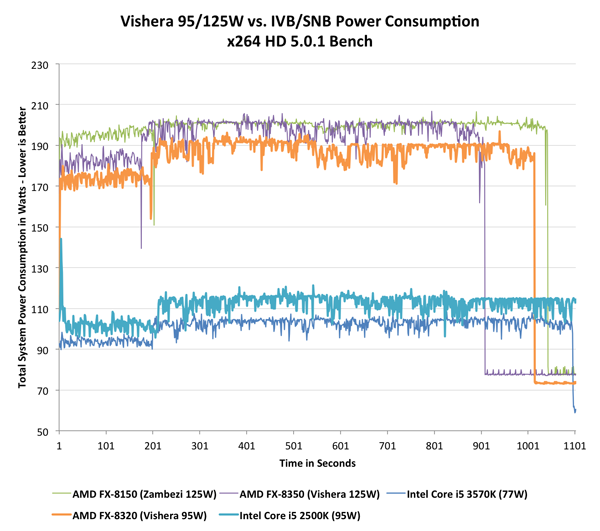Announcement
Collapse
No announcement yet.
AMD FX-8350 "Vishera" Linux Benchmarks
Collapse
X
-
I was wondering why Anand's results were not brought up yet. Michael's tests are heavily mutithreaded, but Anand's seem to be more balanced/representative, imho. Plus, the power consumption graphs are pretty clear-cut.
-
A more modern way to do the testing
Since with specific workloads there's a huge difference between the two in some tests as shown in an older article, I'd like to see all these tests both on intel and amd cpus also done with the code compiled using -Ofast instead of -O3 (also wouldn't mind -O2 since for workloads that don't involve raytracing, computational fluid dynamics or other applications using very large data sets which use a memory addressing pattern which results in a lot of cache misses it seems to be faster over -O3, even postgresql test in mentioned article shows -O2 as better than -O3 and it would be something significant for servers, also some graphicsmagick operations which use adjacent memory locations thus resulting in fewer cache misses).
Leave a comment:
-
These are measurements from Anandtech:


Intel gets the same job done in about the same time, but the whole system consumes about half the power. Idle power consumption is also lower.
Leave a comment:
-
- I asked somebody from heise, in the heise forum, whether they are sure thatOriginally posted by cynyr View PostA quick bit of math:
*CPU is really 125W
*12V line is 168W
if those are true, then the VRM eff is 74.4%. That seems a bit low, but not crazy where I dismiss it outright. Considering the temps the VRMs on my AM3 run I won't be surprised if they need to get rid of ~40 watts.
Heise.de does not state the actual voltage on the 12V line (it's not exactly 12V) nor do they specify the quality of measuring device, or how it was measured. Is it +/-3%? +/-5%? +/-0.001%? what sort of voltage drop is there over the ammeter? Were they accidentally over-volting the CPU? what is the 12V ripple (get out your ocilliscope to measure that) and use that to calculate the RMS voltage. Anyways, there is enough possible error in here that the real TDP could be 125W or so and we have no way of knowing for sure.
only the cpu is fed from the 12V cpu power supply. He says yes. He even
said that sometimes small parts of the cpu (e.g. DRAM drivers) get power from the /other/ power
supply connector, which means the real cpu power might even be higher than
this.
- The VRMs (in this case bucket converters) do certainly much(!) better than 74.4%.
- "Heise.de does not state the actual voltage on the 12V line" => they use a
 The LMG95 single-phase precision power meter is an outstanding product in the proven LMG series of ZES ZIMMER precision power measuring devices.
The LMG95 single-phase precision power meter is an outstanding product in the proven LMG series of ZES ZIMMER precision power measuring devices.
for measuring. Which means they do a proper "multiply volts by amps at any given time giving watts".
And here is how they do it:
 Die elektrische Leistungsaufnahme eines PC hat sich in den letzten Jahren zu einer entscheidenden Kenngröße entwickelt. Mit unserem selbst konstruierten ATX-Messplatz fühlen wir der Leistungsaufnahme sämtlicher Stromkreise eines Rechners auf den Zahn.
Die elektrische Leistungsaufnahme eines PC hat sich in den letzten Jahren zu einer entscheidenden Kenngröße entwickelt. Mit unserem selbst konstruierten ATX-Messplatz fühlen wir der Leistungsaufnahme sämtlicher Stromkreise eines Rechners auf den Zahn.
Regards
Multics.Last edited by multics; 24 October 2012, 04:14 AM.
Leave a comment:
-
Again, you are probably saving power going with the AMD chip because of the lower idle power usage. Very few people run their machines at 100% and then shut them off immediately when finished. Most people are running at idle 99% of the time.Originally posted by necro-lover View Postnow calculate again with the german price : 0,25euro per 1kw.
11.52kWh per month=138,24kWh per year
138,24*0,25=34,56
now your price difference: 150dollar is ~ 120 euro
now 120euro/34,56euro= 3,47222222222 years.
in fact if you use your super new PC 3,5 years the intel one is cheaper.
The reason a high TDP is bad news, is because it indicates that AMD is clocking the chip up as fast as they possibly can, meaning there may not be a lot of extra headroom easily available under this design. But as far as this chip itself, that shouldn't be a problem.
Leave a comment:
-
In defend of heise.de
I think the other poster that mentioned the heise.de article, did not provide all information
that is included in the original article.
(in German: http://www.heise.de/ct/meldung/AMD-A...i-1734298.html )
- All tests were done using Cinebench
- They wrote that the CPU used up to 168 Watts, while talking -indeed- about TDP
(but also said that the voltage (so called bucket) converters draw some power).
- They said that "125 Watt TDP ist pures Wunschdenken" meaning that, 125 Watt
TDP is plain wishful thinking on AMDs side.
So, at least for me, heise says that "using the 12V CPU supply connector as sample point on our
mainboard this particular AMD CPU used well over 125 TDP which AMD claims
it has". They did not mention however, what their test rig exactly is. I would
very much like to know what the integration time for power measurements
were.
(and by the way: Given above is correct, I agree to the OP, that AMD's CPU suck, powerwise. :-D
)
Mind you that TDP is per (Intel) definition a MAXIMUM figure. As otherwise
you weren't be able to properly design and dimension a cooling solution for
a given processor. Note: Power drawn might be higher than TDP for a (very) short
time if the average power is =TDP.
Greeting from Germany, and please forgive bad English you encounter.
CheersLast edited by multics; 23 October 2012, 10:02 PM.
Leave a comment:
-
A quick bit of math:Originally posted by SavageX View PostNo, this is measured on the 12 Volt CPU supply line. It includes only the CPU and voltage regulators, so not *everything* is CPU power consumption (the voltage regulators do not ooperate at 100% efficiency), but certainly most is.
*CPU is really 125W
*12V line is 168W
if those are true, then the VRM eff is 74.4%. That seems a bit low, but not crazy where I dismiss it outright. Considering the temps the VRMs on my AM3 run I won't be surprised if they need to get rid of ~40 watts.
Heise.de does not state the actual voltage on the 12V line (it's not exactly 12V) nor do they specify the quality of measuring device, or how it was measured. Is it +/-3%? +/-5%? +/-0.001%? what sort of voltage drop is there over the ammeter? Were they accidentally over-volting the CPU? what is the 12V ripple (get out your ocilliscope to measure that) and use that to calculate the RMS voltage. Anyways, there is enough possible error in here that the real TDP could be 125W or so and we have no way of knowing for sure.
Leave a comment:
-
Threading Monster
Looking at the results here and elsewhere I conclude AMD has a multithreading monster on it's hands. Single thread not so great but improved over BD.
I had hoped that Bulldozer would be the One, and I think this CPU is about 90% of the One.
Keep in mind that this arch was from word go targeting server & HPC workloads, and not spotty faced overclocking boys shooting at 3D monsters.
Leave a comment:
-
don't know what to do with your words as a feedback to my words: "unlocked cpu+virtualization+ECC non-reg ram."Originally posted by phred14 View PostThese (parent and grandparent post) are some of the more significant posts I've read. Intel is capable of excellent technical work as they have proven many times, and are currently proving with the entire Banias - through - Ivy Bridge line. But they also have a strong marketing division that frequently seems to work at odds with directions that chip-head users present here might like. It is important to realize that from a corporate decision making point of view, it appears that at Intel, marketing trumps technical design.
Hence not that long ago we got the "Oooh, Fast!" NetBurst designs, and the "clone proof" IA64 designs. Because the Core-X line has been hammering AMD to the edge of existence, we're now seeing "revenue maximizing" stunts like disabling on-chip features unless you've paid extra. Kick AMD all you like, but if they're gone Intel has proven multiple times that, absent meaningful competition, they wander way off-target and we the customers lose. I don't know if ARM will provide proper competition for Intel in the future, at least partly because Microsoft has managed to lock down ARM-based hardware to be Windows-only, preventing it from growing into a true general-purpose platform.
my words mean if you want a pc with ALL virtualization funktions +unlocked CPU+ECC RAM you need to buy AMD because intel just don't sell products like this.
Leave a comment:
-
now calculate again with the german price : 0,25euro per 1kw.Originally posted by Sidicas View PostShow me your numbers... Right now....
Don't spread bullshit.
Power here in New York is much more expensive than it is in the rest of the USA.
The CPU uses what? 48W more power?
Using the PC 8 hours a day...
48 * 8 = 384Whr more power per day
30 days a month...
384Whr * 30 days = 11.52kWh per month
Cost per kWh here in New York...
(https://www.nationalgridus.com/niaga...our_charge.asp)
57 dollars for 1000kWh (1MWh).... and that's assuming I use it during the worst time of day.
Extra electrical cost to use the AMD CPU rather than the Intel CPU per month...
11.52kWh / 1000kWh = x/$56.63
X=$0.65
Whoopie, we saved 65 cents a month.
Price difference between CPUs...
AMD FX-8350 = $220 (NewEgg.com)
Intel 3770K = $320 (NewEgg.com)
Difference = $100
How many months is it going to take to pay for the CPU price difference?
$100 / $0.65 = 153 months
How many years is that?
12.75 years
But wait, there's more... Intel motherboards are generally more expensive than AMD boards as well.
Maybe an extra 50 dollars more. So we need to add another 6 years onto that....
Of course, I love advanced fab chips, but when companies like Intel intentionally make their chips and motherboards overpriced by so much, any kind of power savings goes flying out the window instantly.
11.52kWh per month=138,24kWh per year
138,24*0,25=34,56
now your price difference: 150dollar is ~ 120 euro
now 120euro/34,56euro= 3,47222222222 years.
in fact if you use your super new PC 3,5 years the intel one is cheaper.
Leave a comment:

Leave a comment: